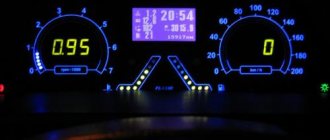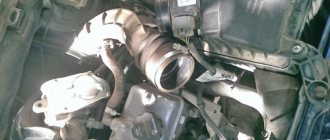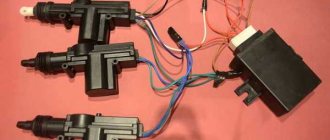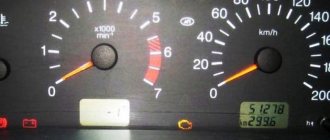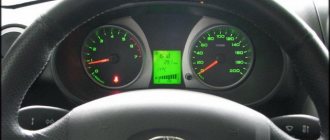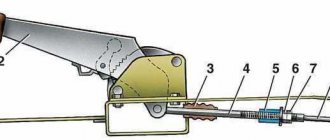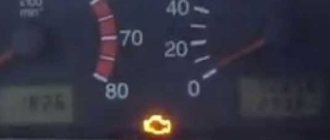When the speedometer does not work on a VAZ-2112 hatchback, the reasons may be different. Usually they try to repair the tidy, but the speed sensor turns out to be faulty. The ECU detects a malfunction of this sensor with difficulty, and the CHECK lamp does not turn on. The fact that the speed sensor is broken has to be identified by the following signs: idle speed always remains low, and the engine stalls when changing gears. These nuances will be discussed in more detail below, but we will only talk about 16-valve valves.
If all devices do not work, then one fuse is at fault. The video shows which one.
Principle of operation
Domestic VAZ-2112 cars with a 16-valve power unit are equipped with an electromechanical speed calculation system. It consists of the following elements.
- The speed sensor is the main element of the circuit. It is an electronic modernized pulse Hall sensor with a rod equipped with a gear.
- Electrical wiring that provides connection between the electric control unit and the on-board computer, fuse box, and instrument panel.
- Electrical fuse and contact relay. Provide protection against voltage surges in the network.
- Electronic drive of the speedometer itself.
The operation of the entire system is ensured as follows:
- An electromechanical speed sensor is installed on the vehicle's gearbox. It is driven by the drive gear of the gearbox. Rotation is transmitted through the EMF driven gear.
- Rotation is converted into electrical impulses. For 1000 revolutions, 6004 pulses are generated.
- Electrical impulses through the wires, or more precisely through the “2” wire of the electrical connector, enter the on-board computer.
- The ECU calculates the received signals, transferring them further along the circuit to the speedometer receiver drive.
- Electrical voltage with a certain current strength acts on the speedometer electric motor, causing it to turn at a certain angle.
This system is as reliable as possible. But, due to some factors, it also fails. The following will describe the symptoms that precede a speedometer malfunction.
What else is the reason for the speedometer not working?
However, often the reason for the speedometer malfunction lies elsewhere:
- Oil and dust get into the speed sensor, which is located in the engine compartment under the hood of the car.
The malfunction is eliminated after removing dirt and oil by washing the sensor. If the DS fails and needs to be replaced, any car owner can perform this simple operation independently. The replacement sequence is as follows:
- place the machine on a flat horizontal surface;
- open the hood and find the speed sensor on the gearbox;
- by pressing the latch bracket, the plug is disconnected from the DS:
- to remove the sensor, use a 22 mm wrench, turning it counterclockwise;
- The new part is installed by screwing it in by hand. The use of a wrench is not recommended, as you may miscalculate the rotation and break the thread;
- install the connector, as evidenced by the click of the fixed part.
The driver should buy a new DS with similar markings. Otherwise, the speedometer needle will display incorrect readings.
- For some unknown reason, the VAZ 2110 speedometer stopped working. First of all, you need to check the most accessible elements associated with the speedometer. Since the car compartments are not ideally clean, dirt and moisture can damage any part, including wires and contacts.
Under the influence of moisture and dirt, wires and contacts can oxidize. Eliminating this cause is simple: the contacts must be removed, cleaned of oxidized deposits, wiped dry and reinstalled. It is also necessary to check the integrity of the wires.
Externally good wires may have broken sections of cores inside. Checking the serviceability of the wires involves ringing their surface with a tester.
During operation, the splines and elements that rotate the speedometer cable may be damaged. Such a defect may impair the operation of the instrument panel. You can verify its serviceability by testing it.
- The third, very important defect is the malfunction of the speed sensor. This device is located on the gearbox, adjacent to the exhaust manifold. This factor leads to heating and chafing of the DC wires.
The reasons for the sensor being out of working condition, the fault can be determined at the service center. The technician will perform this procedure in the presence of the car owner. To troubleshoot the problem yourself, you should do the following:
- The speed sensor must be removed by unscrewing it from the gearbox;
- connect the DC wire to a screwdriver or drill, set the rotation counterclockwise;
- turn on the ignition.
The movement of the arrow indicates that the sensor is working properly. The weak link is most likely located in the vehicle's transmission. It is difficult for a driver without experience to cope with this task.
In this case, the problem must be solved by car service specialists. If the speedometer needle on a VAZ 2110 does not work, the speed sensor must be replaced.
The speedometer on a VAZ 2110 with an injector is an important element of any car, not excluding the “top ten”. VAZ 2110 drivers even with little experience can check and find the source of the malfunction of this device.
However, if you cannot determine the source of the speedometer problems, you need to draw the attention of technical service specialists to this problem.
As you know, devices installed in a car allow you to monitor the situation while driving on the streets and monitor the operation of the engine and all other systems. Among others, the speedometer occupies a special place. It is located on the dashboard directly above the steering wheel. With its help, the driver finds out at what speed the car is moving.
In a situation when the speedometer and the injector installed on the VAZ-2110 do not work properly, the person behind the wheel puts both his own health and the lives of passengers at risk. At the same time, he can easily “earn” a fine from a traffic police officer for speeding too high. Thus, a working speedometer allows you to avoid a considerable amount of trouble.
Symptoms
When the VAZ-2112 speedometer does not work, the car owner is faced with a number of symptoms that manifest themselves in the performance of the engine. The operation of the injection system requires the simultaneous combination of almost all electronic sensors in the circuit. The ECU calculates the mixture and fuel supply based on many data coming from the electronic components of the machine. Symptoms of a non-working speedometer are as follows:
- Notification of on-board computer errors P0501 - P0503. These errors indicate an increase or decrease in the power of the pulses emanating from the EMF.
- A "Check Engine" alert often comes with these codes. The reason is an incorrect calculation based on incoming signals from the EMF.
- Partial or complete stoppage of the speed meter needle.
- Problems when starting a cold power unit.
- Noticeable loss of power.
- The power unit is unstable, especially when accelerating or shifting into gear.
- There is a noticeable increase in fuel consumption.
If clear signals from the speedometer sensor are lost, the on-board computer incorrectly calculates the required amount of fuel and the proportion of air in it. For this reason, speed stability decreases, consumption increases, and a significant part of the power and dynamics is lost. If the described symptoms appear, the owner can independently diagnose all components of the speed calculation using the instructions below.
Signs and causes of DS problems
VAZ “tens” are equipped with pointer indicating devices, i.e. the speed is judged by the angle of its deflection. If, while driving, the speedometer needle jumps and jumps, lies at “zero” or shows values that do not correspond to the true ones, and the odometer does not record the distance traveled, then this indicates a breakdown of the DS.
This situation occurs due to contamination of the sensor contact block, since the primary device is located on the gearbox housing under the hood and is not protected from dirt. The pad may be exposed to oil vapors penetrating through damaged seals. This leads to loss of contact and, as a result, incorrect speedometer readings. Such a breakdown can occur both with sensors with a square connector and with a round one. The difference between them is that the former are used in Bosh systems, and the latter in January 4 and GM.
When the speed sensor fails, unstable engine idling is often observed, and fuel consumption also increases. In this case, the DS is replaced. When choosing a working sensor, it is advisable to choose a model that is identical to the old one. Preference is given to products whose pinouts are indicated in the form of “-”, “A” and “+” rather than a digital designation. This will help when repairing the device and measuring the output signal.
Examination
The speedometer on a VAZ-2112 car does not work for reasons related to the mechanical and electronic parts of the speed calculation system. All elements must be checked one by one.
Safety relay
This electronic element is located in the safety block under number “6”. Responsible for the secondary power supply of the ignition system, or rather passive electrical devices (panel, interior lamps, radio, speedometer, tachometer).
To check this relay, you must:
- Switch the tester to constant voltage test mode.
- Turn on the ignition.
- Find fuse "F19".
- Connect the red test lead to the top contact of the fuse.
- Connect the black test probe to ground.
The tester should show a voltage equal to the battery charge. At least 11 volts. Often, when this relay fails, the on-board electrical power is turned off. This test only helps to test the integrity of the contact between the relay and the fuse.
Fuse
This fusible element is located in the safety block marked “F19”. To check, you need to remove the part and inspect it visually. It is also worth inspecting its landing site. Both contacts must be cleaned of dirt and oxidation. It is worth paying special attention to the presence of burnt contacts and melted body of the unit. Voltage drop is not the only reason for fuses to fail. Heating as a result of poor contact leads to melting of the housing, contacts, and fuse mounting location. If a visual inspection of the fuse does not produce results, it must be tested with a multimeter. To do this, connect the measuring probes to the contacts of the element, and switch the device to the continuity mode. The absence of an audible warning will indicate a malfunction. The protective fuse will have to be replaced with a 10 A analogue.
It is not recommended to insert analogs of a lower or higher value instead of a protective element. It is also prohibited to use wire, coins, or any foreign metal objects. They will not protect against overload.
Speed sensor
This node is checked in several stages. Initially, you need to disconnect the power plug of this unit in order to check the integrity of the contacts. Any oxidation, dirt or moisture found must be cleaned with a solvent.
The following is a performance test:
- The car is raised on a jack.
- A wire is drawn from the battery, which is connected at one end to the “+” terminal on the battery, and at the other to the “1” terminal of the sensor.
- The second wire is connected at one end to the “ground” or “-” of the battery, and the other to terminal “3” of the EMF.
- The tester switches to DC voltage measurement mode.
- The red test lead is connected to terminal “2” of the sensor.
- Black test lead with ground.
- Next you need to turn the drive wheel of the car.
The tester should output pulsed voltage data up to 12 volts. The number of pulses should increase as the number of revolutions of the drive wheel increases. If there are pulses, then the sensor can be recognized as working. If they are not there, then the mechanism requires dismantling.
In order to dismantle the part you will need a key “22”. With its help, being careful, you need to unscrew the EMF from the installation site. The part has a plastic case and can be easily damaged with a key. The dismantled mechanism must be inspected.
- There should be no cracks or chips on the body. The presence of defects can cause a short circuit to the housing. If such damage occurs, the part requires replacement. Solving the problem with sealant, insulating tape, or glue is prohibited. High revs will destroy these compounds.
- The rod should not have any backlash, distortion, or bending. Such malfunctions cannot be eliminated, since it will not be possible to achieve ideal direction. The EDS will have to be replaced.
- The most important mechanical part is the driven gear. The presence of broken, worn, or bent teeth will indicate a malfunction with subsequent replacement of the rod and gear as a set.
- If the sensor is fully operational, you need to check the integrity of the drive gear. To do this, you will have to spin the drive wheel of the car. You need to turn the wheel slowly in order to examine in detail all the teeth of this part. The presence of chips or wear will indicate a violation of integrity. Repairing the gearbox will help solve the problem. Perhaps the condition of the gear was affected by foreign solid objects in the manual transmission housing, broken teeth or parts of other mechanisms.
Speedometer Troubleshooting Options
Failure of the speed sensor is not the only reason for the lack of speedometer readings. The performance of the latter can be affected by a break in the connecting wires or a lack of contact in the terminal block, as well as a breakdown of the indicating device. If, when checking the DS, it turns out to be serviceable, then the search for the defect continues from the block to the speedometer. To ensure the integrity of the line and check the device for functionality, you need to use a test lamp.
To do this, one control wire is connected to the negative terminal of the battery and the ignition is turned on, and the other wire is often touched to contact “A” of the block, creating a kind of impulse. In this case, the speedometer needle should deviate from its original position. If the effect is achieved, then this section of the kit is serviceable, otherwise they begin checking the integrity of the circuit from the block to the fuse and then to the device. If the result is negative, we can talk about a device malfunction.
Replacing the speedometer is carried out with the instrument panel, since the industry does not produce spare parts for its repair. According to statistics, only in 7% of such malfunctions the inoperative element is the indicating device. If the speedometer kit is operational, but signs of malfunction remain, then most likely the drive gear located in the gearbox has broken down. It is recommended that such repairs be carried out at a service station, since it is necessary to dismantle the gearbox and disassemble it.
On the “dozens” of the first releases, speedometer problems can arise as a result of a broken drive cable or if the edges of the tip are “licked”. In this case, the cable is dismantled and replaced with a working one. If the speedometer drive socket is damaged, it must also be replaced.
The speedometer on the VAZ-2112 16 valves does not work
When the speedometer does not work on a VAZ-2112 hatchback, the reasons may be different. Usually they try to repair the tidy, but the speed sensor turns out to be faulty. The ECU detects a malfunction of this sensor with difficulty, and the CHECK lamp does not turn on. The fact that the speed sensor is broken has to be identified by the following signs: idle speed always remains low, and the engine stalls when changing gears. These nuances will be discussed in more detail below, but we will only talk about 16-valve valves.
If all devices do not work, then one fuse is at fault. The video shows which one.
Speed sensor malfunctions
Signs of a sensor malfunction may include:
- unstable operation and incorrect speedometer and odometer readings;
- cessation of stable engine operation at idle;
- errors generated by the computer (P0500 – no sensor signal, P0503 – intermittent sensor signal).
The problems listed above may result from:
- poor contact in the sensor connector due to contamination;
- violation of the integrity of the wiring from the sensor to the ECU;
- mechanical failure of the DS drive (in older VAZ 2110 models).
Do I need to change
Not only the speedometer and odometer readings, but also the quality of the fuel mixture supplied to the cylinders, the idle speed of the vehicle, engine stability and fuel consumption depend on the information received by the ECU from the sensor.
A failed DS will “confuse” the electronic unit, which simply will not understand whether the car is moving or standing still. As a result, the speed will begin to fluctuate, the engine will stall at idle, and fuel consumption will increase.
Checking a mechanically driven speed sensor is not difficult. On the removed sensor, we find the pin and turn it with pliers, having attached the connector to it in advance. If the speed sensor is working, the arrow on the instrument cluster will jump, if there is no reaction, then there is a problem with the drive or electrical wiring.
Checking the wiring to the instrument cluster is also not difficult, take a paperclip (you can use any other metal object) and insert it into the middle pin on the connector, then touch it to the engine housing, the arrow on the combination should twitch, otherwise you need to look for the cause in a wiring fault or sensor connector (oxidation, breakage, etc.).
Electrical diagram
The sensor itself is powered by a voltage of 12 Volts (pink-black cord), and another pin is connected to ground. The gray wire is the sensor output. It is connected to the voltage source through a resistor (see figure).
Typical connection diagram for DS on a VAZ-2112.
None The diagram shows that the output is connected to the ECU terminal. Terminal number:
Another gray cord goes to the “red” block on the dashboard, where it connects to terminal 9. As you can see, everything is simple.
Dismantling
To remove the sensor from the car, you need to disconnect its connector. The sensor housing is fixed near the CV joint - the desired point is shown by an arrow. When the connector is disconnected, take a flat key “22” and unscrew the plastic nut. Then you can change the sensor or repair it.
What you need here is a flat wrench. To replace the sensor drive, use a “10” wrench to unscrew the M6 nut and remove it together with the washer. The drive housing is rocked from side to side - you need a 14mm spanner.
Installation requirements: on the one hand, it is necessary to obtain a tight seal, on the other hand, the plastic must not be broken.
Mechanics
The following diagram shows exactly how the speed sensor is designed.
Speed sensor for VAZ-2112
- 2110-3843010-13 – sensor;
- 2110-3843010-18 – sensor;
- 2108-3802820-10 – speedometer drive;
- 2101-3802718 - pad;
- 2108-3802822 – drive housing;
- 2108-3802830 - sealing ring;
- 2108-3802834-20 – driven gear;
- 2108-3802833-20 – drive gear;
- 2101-3802717 - washer;
- 15896211 – M6 nut;
- 12601271 – wavy washer;
- 11500121 – pin M6x14.
Elements 1 and 2 are interchangeable.
Dismantling
To remove the sensor from the car, you need to disconnect its connector. The sensor housing is fixed near the CV joint - the desired point is shown by an arrow.
When the connector is disconnected, take a flat key “22” and unscrew the plastic nut. Then you can change the sensor or repair it.
What you need here is a flat key
To replace the sensor drive, use a “10” key to unscrew the M6 nut and remove it together with the washer. The drive housing is rocked from side to side - you need a 14mm spanner.
Installation requirements: on the one hand, it is necessary to obtain a tight seal, on the other hand, the plastic must not be broken.
Dashboard connectors and speedometer contacts
The dashboard, as well as the speedometer on the VAZ-2112, may not work when they are disconnected from ground or power. Be aware that the speedometer receives power separately from the instrument panel. This also applies to the “mass”. Wiring:
- X2-2 : +12V to the speedometer;
- X2-3 : speedometer “mass”;
- X1-9, X1-10 : power supply for tidy;
- X1-1 : “mass” of the tidy.
Connector X2 is painted red, X1 – white. Terminals 8 and 9 in connector X2 are the speedometer output and input. The output is connected to the on-board computer.
Both terminals (X1-9 and X2-2) are connected to one wire - orange. This line is protected by a fuse installed in the main mounting block (F19).
Instrument panel test on video (speedometer self-diagnosis)
There are some things we don't specifically consider.
Power to the circuit shown in the previous chapter comes from main relay 6. It is also called the “ignition relay”. There is also fuse 1 in the circuit.
Additional relay and fuse box
When the ignition circuit is broken, both the speedometer and the ECU module do not work on the VAZ-2112, and the engine does not start at all. So advice about checking the relay would seem stupid.
Advice for those who have an oscilloscope
If you still decide to dismantle the sensor, connect a 1 kOhm resistor to its output (to the middle terminal). The resistor tap is connected to the “plus” of the power supply. By turning the shaft by hand, pulses can be observed at terminal 2. There are six pulses per revolution.
How to remove the tidy
First, disconnect the negative terminal of the battery. Then use a screwdriver to unscrew the 4 screws (photos 1 and 2) to remove the frame with glass.
- If you connect the battery and turn on the ignition, the orange cord (connectors X1 and X2) should receive voltage “+12”;
- The presence of “ground” at terminal X2-2 is also a very important indicator;
- The gray cord (terminal X2-9) is usually called “+12”, and in rare cases - “ground”. When moving, pulses should appear at this terminal.
Sometimes they do this: they make a tap from terminal 9, and, without engaging the gear, move (push) the car. The engine remains switched off. Pulses will appear on the tap, detectable even with a voltmeter. The voltmeter itself must be a pointer type.
The presence of pulses indicates a malfunction of the speedometer, and the absence of pulses indicates a malfunction of the sensor. However, the speed sensor may not receive power or ground (see above).
It will not be possible to fix a faulty speedometer - it will be easier to replace it. But first you need to find out exactly what the problem was.
Signs of device failure
The fact that there is trouble with the speedometer is evidenced, first of all, by the immobility of its needle while the car is moving. In this situation, the driver must immediately proceed (with all precautions) to a service station or garage.
You should suspect that the device is not working when the arrow:
- begins to fluctuate sharply;
- freezes periodically;
- shows the speed while the engine is warming up, and stops as soon as it starts moving.
In all cases, it is important to find the causes of the breakdown.
Video with instructions for replacing the sensor
A car's speedometer is an important component of a safe and comfortable trip. Every car owner knows what this device is intended for, but not everyone can immediately figure out the reason why the speedometer stopped working. And this is an unpleasant thing when the speed indicator shows incorrect numbers or has stopped functioning altogether.
There is a high probability of speeding and getting a fine from a traffic police officer. Or not fit into the turn at all. To avoid these unpleasant situations, you should know the principle of operation of the device and the most likely causes leading to its failure.
Expert recommendations
Driving with a faulty speedometer poses a danger both to others and to the car owner himself. When a problem is discovered, it should be corrected immediately. If the driver himself is unable to do this, he will have to take the car for repair to a specialized service center or service station.
But most problems are fairly easy to repair with your own hands. If suddenly the speedometer no longer displays the correct data, then you should not panic.
It usually happens that the breakdown consists of faulty wiring, oxidation of contacts and other easily correctable disturbances in the transmission of electrical signals. It is not difficult to detect such a breakdown; it is enough to carry out a visual inspection, during which the cause of the malfunction will immediately become obvious. Then you can fix the breakdown on the VAZ 2110 with your own hands - it won’t be difficult.
Contamination of the controller can also cause a malfunction. You need to remove it and clean it, and then install it back. Often this procedure is enough to make repairs when the speedometer on a VAZ 2110 car stops working.
The proper operation of the speedometer is important while driving, and many repair methods are simple and accessible to most drivers
Therefore, you should not delay the diagnosis and repair of this important device.
Useful video:
Reasons why the VAZ 2110, 2111, 2112 speedometer stopped working
The operation of any speedometer is based on the Hall effect. The controller receives data from the speed sensor, which produces a signal proportional to the tire rotation speed. On cars of the “tenth” VAZ family, one of the most common reasons for speedometer failure is contact oxidation. Cleaning them will take about 10-15 minutes; this is the simplest and most effective solution to the problem.
This video describes the reasons why the speedometer on a car does not work: But, if this does not help and the speed meter still refuses to work in a VAZ 2110, VAZ 2111, VAZ 2112, then the owners of these cars will have to prepare for more painstaking work. The following possible malfunctions include:
- Deformation of wires in domestic cars is also a common problem. It is necessary to visually check all wires for defects. If nothing was found, to be completely sure, “ring” the wire; the internal conductors may be damaged;
- The fuse should be checked. It may simply simply burn out;
- The problem may be hidden in the speed sensor itself. In VAZ 2110, 2111, 2112 cars, in this case, it is necessary to urgently replace the faulty mechanism. But, first, it’s still worth checking the mechanism for functionality: remove the device from the box and connect a drill to the device. If it is working properly, then torque will be transmitted to the device;
- It is advisable to check the instrument panel for faults. If the instrument panel was removed, then incorrect reinstallation could result in the arrow touching the trim.
These are the most likely reasons that answer the question: why does the speedometer not work? This principle should be observed for both owners of an “injector” engine and owners of a “carburetor”. If, after going through all the procedures, the problem was not detected and solved, then in this case it is necessary to carry out a comprehensive diagnosis of the vehicle.
What else is the reason for the speedometer not working?
However, often the reason for the speedometer malfunction lies elsewhere:
- Oil and dust get into the speed sensor, which is located in the engine compartment under the hood of the car.
The malfunction is eliminated after removing dirt and oil by washing the sensor. If the DS fails and needs to be replaced, any car owner can perform this simple operation independently.
The replacement sequence is as follows:
- place the machine on a flat horizontal surface;
- open the hood and find the speed sensor on the gearbox;
- by pressing the latch bracket, the plug is disconnected from the DS:
- to remove the sensor, use a 22 mm wrench, turning it counterclockwise;
- The new part is installed by screwing it in by hand. The use of a wrench is not recommended, as you may miscalculate the rotation and break the thread;
- install the connector, as evidenced by the click of the fixed part.


